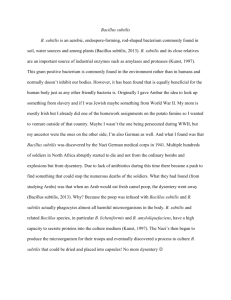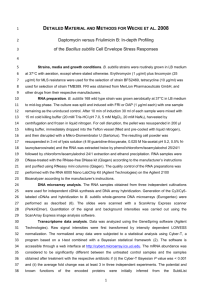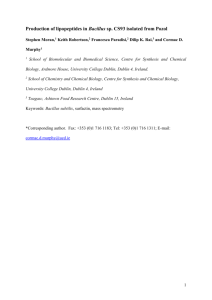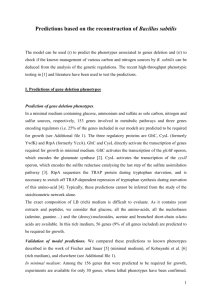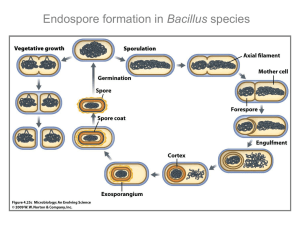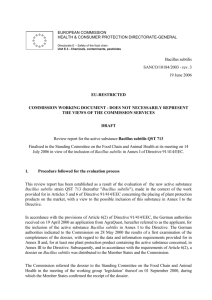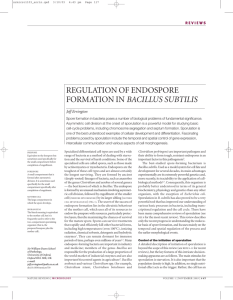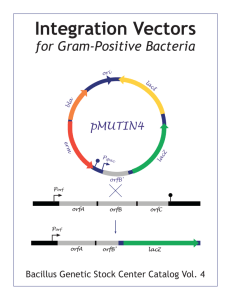Moran et al_manuscript_rev4
advertisement
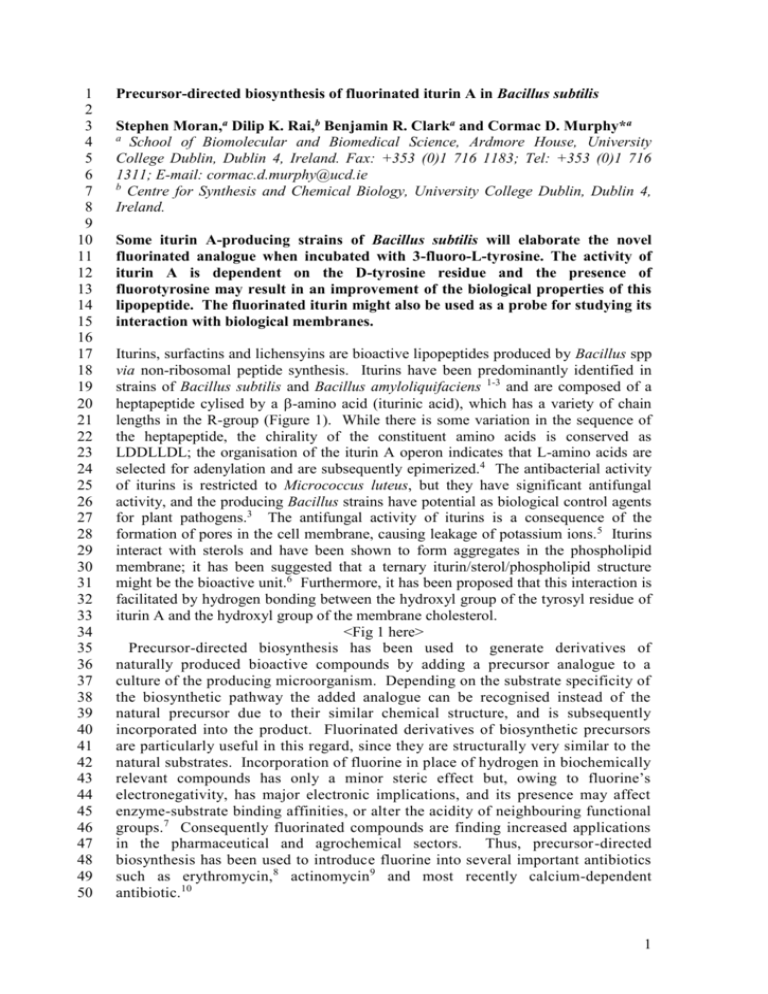
1 2 3 4 5 6 7 8 9 10 11 12 13 14 15 16 17 18 19 20 21 22 23 24 25 26 27 28 29 30 31 32 33 34 35 36 37 38 39 40 41 42 43 44 45 46 47 48 49 50 Precursor-directed biosynthesis of fluorinated iturin A in Bacillus subtilis Stephen Moran,a Dilip K. Rai,b Benjamin R. Clarka and Cormac D. Murphy*a a School of Biomolecular and Biomedical Science, Ardmore House, University College Dublin, Dublin 4, Ireland. Fax: +353 (0)1 716 1183; Tel: +353 (0)1 716 1311; E-mail: cormac.d.murphy@ucd.ie b Centre for Synthesis and Chemical Biology, University College Dublin, Dublin 4, Ireland. Some iturin A-producing strains of Bacillus subtilis will elaborate the novel fluorinated analogue when incubated with 3-fluoro-L-tyrosine. The activity of iturin A is dependent on the D-tyrosine residue and the presence of fluorotyrosine may result in an improvement of the biological properties of this lipopeptide. The fluorinated iturin might also be used as a probe for studying its interaction with biological membranes. Iturins, surfactins and lichensyins are bioactive lipopeptides produced by Bacillus spp via non-ribosomal peptide synthesis. Iturins have been predominantly identified in strains of Bacillus subtilis and Bacillus amyloliquifaciens 1-3 and are composed of a heptapeptide cylised by a -amino acid (iturinic acid), which has a variety of chain lengths in the R-group (Figure 1). While there is some variation in the sequence of the heptapeptide, the chirality of the constituent amino acids is conserved as LDDLLDL; the organisation of the iturin A operon indicates that L-amino acids are selected for adenylation and are subsequently epimerized.4 The antibacterial activity of iturins is restricted to Micrococcus luteus, but they have significant antifungal activity, and the producing Bacillus strains have potential as biological control agents for plant pathogens.3 The antifungal activity of iturins is a consequence of the formation of pores in the cell membrane, causing leakage of potassium ions.5 Iturins interact with sterols and have been shown to form aggregates in the phospholipid membrane; it has been suggested that a ternary iturin/sterol/phospholipid structure might be the bioactive unit.6 Furthermore, it has been proposed that this interaction is facilitated by hydrogen bonding between the hydroxyl group of the tyrosyl residue of iturin A and the hydroxyl group of the membrane cholesterol. <Fig 1 here> Precursor-directed biosynthesis has been used to generate derivatives of naturally produced bioactive compounds by adding a precursor analogue to a culture of the producing microorganism. Depending on the substrate specificity of the biosynthetic pathway the added analogue can be recognised instead of the natural precursor due to their similar chemical structure, and is subsequently incorporated into the product. Fluorinated derivatives of biosynthetic precursors are particularly useful in this regard, since they are structurally very similar to the natural substrates. Incorporation of fluorine in place of hydrogen in biochemically relevant compounds has only a minor steric effect but, owing to fluorine’s electronegativity, has major electronic implications, and its presence may affect enzyme-substrate binding affinities, or alter the acidity of neighbouring functional groups.7 Consequently fluorinated compounds are finding increased applications in the pharmaceutical and agrochemical sectors. Thus, precursor-directed biosynthesis has been used to introduce fluorine into several important antibiotics such as erythromycin, 8 actinomycin9 and most recently calcium-dependent antibiotic.10 1 1 2 3 4 5 6 7 8 9 10 11 12 13 14 15 16 17 18 19 20 21 22 23 24 25 26 27 28 29 30 31 32 33 34 35 36 37 38 39 40 41 42 43 44 45 46 47 48 49 50 We adopted a similar strategy by attempting to generate halogenated iturin derivatives via precursor directed biosynthesis. Taking into account the apparent significance of tyrosine in the mechanism of action of iturin A, our main objective was to generate halogenated analogues by incubating halotyrosine with iturinproducing Bacillus spp. Bacillus subtilis CS93, which is a strain originally isolated from Pozol, a fermented dough consumed by the Mayan peoples and used as a medicinal agent to treat intestinal complaints and prevent infection in wounds, was cultured in a defined growth medium, 1 to which 3-fluoro-, 3-chloro- or 3iodo-L-tyrosine§ was added after 24 h (0.05 or 0.5 mmol). Control cultures, which were not supplemented with halotyrosine, were grown in parallel. The growth of the cultures was monitored via optical density measurements and aliquots (1 ml) of the culture supernatants were removed and analysed by liquid chromatography-mass spectrometry (LC-MS).‡ Addition of 3-fluoro-L-tyrosine to the growing culture of B. subtilis CS93 resulted in an extended lag phase. Furthermore, the length of the lag period depended on the amount of 3-fluoro-L-tyrosine added (Figure 2). The inhibition of microbial growth by 2- and 3-fluorotyrosine has been observed.11 Analysis of the B. subtilis CS93 supernatant by 19F nuclear magnetic resonance spectroscopy revealed that no degradation of the fluorotyrosine occurred (not shown), thus the extended lag period was most likely due to the growth of a small number of fluorotyrosine-resistant bacteria in the inoculum. This suggestion is supported by the observation that when fresh medium containing fluorotyrosine was inoculated from a culture previously exposed to the compound, no inhibition of growth was observed (Figure 2). Addition of 3-chloro-L-tyrosine to the B. subtilis CS93 resulted in complete inhibition of growth; the presence of iodotyrosine did not affect growth. <Fig 2 here> Electrospray MS analysis of supernatants from cultures incubated in the absence of 3-fluoro-L-tyrosine revealed ions at m/z 1043.5 and m/z 1057.6 representing the characteristic molecular ions of iturin A containing iturinic acids with 14 and 15 carbon atoms, respectively (Figure 3) known to be produced by this strain. 1 The ions m/z 1065.5 and m/z 1079.6 were also evident and are sodiated forms of the two iturin A molecular ions. In the presence of 3-fluoro-L-tyrosine, new compounds appeared, which eluted just after the iturins, and are 18 Da heavier than the iturin A molecular ions (m/z 1061.6 and m/z 1075.6; Figure 3). This is entirely consistent with the presence of a fluorine atom and strongly suggests the incorporation of 3-fluoro-D-tyrosine in place of D-tyrosine. The incorporation of fluorine into iturin A is further supported by the observation of sodium adducts at m/z 1083.4 and m/z 1097.5 (the M+1 isotope peak is labelled in Fig 3). High resolution mass spectometry performed on a Micromass LC-time-of-flight instrument revealed the masses of these adducts to be 1083.5243 and 1097.5416, respectively, which fall within the acceptable ranges of the calculated masses (1083.5251 and 1097.5407, respectively). Furthermore, LC-MS/MS analysis of the supernatants, and comparison of the spectra with natural iturin A confirmed the replacement of tyrosine with fluorotyrosine (ESI). The fluoriturins were purified from culture supernatant║ by reversed phase solid-phase extraction and HPLC, yielding two purified fluoroiturins (C-14 and C-15). While the low amount of material isolated precluded a full spectroscopic analysis, 1H and 19F NMR (d6DMSO) proved crucial in confirming the structures of the new metabolites. 1H NMR analysis of the new metabolites gave data almost identical to those for nonfluorinated iturins, but for several crucial differences in the aromatic region. The 2 1 2 3 4 5 6 7 8 9 10 11 12 13 14 15 16 17 18 19 20 21 22 23 24 25 26 27 28 29 30 31 32 33 34 distinctive 2H tyrosine doublets (H 7.01, d, J = 8.4 Hz; H 6.65, d, J = 8.4 Hz)12 were absent, replaced with a 1H doublet (H 7.00, d, J = 8.5 Hz) and a 2H multiplet (6.86 ppm) consistent with the presence of a flurotyrosine residue. Furthermore, 19F NMR analysis revealed the presence of a single characteristic 19F resonance for each of the fluoroiturins at -136.7 ppm (fluorotyrosine F -136.8), confirming the successful incorporation of fluorotyrosine. No new compounds were detected when iodotyrosine was added to B. subtilis CS93 cultures. <Fig 3 here> By employing an authentic standard of iturin A it was possible to quantify its concentration in culture supernatants by LC-MS.¶ The concentration of iturin in supernatants from cultures incubated in the absence of fluorotyrosine was 40 µg/ml. In the presence of fluorotyrosine the concentration of iturin was 4 µg/ml, while the concentration of fluoroiturin was approximately 16 µg/ml. Bacillus strains 2090 and 2031, and B. mycoides 4079 13 were also examined for their ability to incorporate 3-fluoro-L-tyrosine into iturin A. However, while iturin A was detected in the culture supernatants of these bacteria, fluoroiturin was only detected in the supernatant of strain 2090 incubated in the presence of 0.05 mmol 3-fluoro-L-tyrosine, indicating that the relaxed substrate specificity of tyrosine incorporation is not universal amongst iturin A producers. Similarly, no fluorinated bacillomycin D was detected in the culture supernatants of B. subtilis NCIMB 8872. The D-tyrosine residue has been identified as playing a significant role in the antibiotic properties of iturin A. Methylation of the tyrosine residue in iturin results in a significant reduction of the antimicrobial activity towards M. luteus 14 and Saccharomyces cerevisiae,15 consistent with the suggestion that the aromatic hydroxyl of the tyrosyl residue interacts with membrane sterols via hydrogen bonding.16 The pKa of tyrosine and 3-fluorotyrosine is 10 and 9, respectively,17 thus replacement of tyrosine for fluorotyrosine in iturin might make the hydroxyl a better hydrogen bond donor since it is more acidic. It is now a clear objective to scale up the isolation of the fluorinated iturin and quantitatively assess its antimicrobial activity. Since the amount of fluoroiturin produced by this strain is relatively poor compared to the amount of fluorotyrosine added, further screening will be necessary to isolate an iturin-producing strain that incorporates 3-fluoro-L-tyrosine more effectively. 35 Notes and references 36 37 38 39 40 41 42 43 44 45 46 47 48 † Electronic Supplementary Information (ESI) available: LC-MS/MS analysis of iturin and fluoroiturin; calibration graph of authentic iturin A. See DOI: 10.1039/b000000x/ § Halotyrosines and authentic iturin A (≥ 90%) were purchased from Sigma. ‡ Samples of cultures were removed and centrifuged. Supernatant (10 l) was injected onto the Waters Alliance 2695 HPLC system (Waters, Milford, MA, USA) interfaced to a tandem quadrupole mass spectrometer. The mobile phase consisted of 60% water containing 0.05% formic acid and 40% acetonitrile pumped isocratically at 0.2 ml/min at ambient temperature. Chromatographic separation of analytes was achieved using an Atlantis T3, 3 m (100 mm x 2.1 mm i.d.) reversed-phase C18 column. Electrospray ionisation mass spectrometry analyses of the samples were 3 1 2 3 4 5 6 7 8 9 10 11 12 13 14 15 16 17 18 19 20 21 22 23 24 25 26 27 28 29 30 31 32 33 34 35 36 37 38 39 40 41 42 43 44 45 46 47 48 49 performed on a Quattro microTM mass spectrometer (Waters Corporation, Micromass MS Technologies, Manchester, UK). The capillary voltage and the cone voltage of the instrument were set at 3.5 kV and 35 V respectively. Mass spectra were recorded on a positive ion mode for a mass range m/z 100 to m/z 1400. For the LC-MS/MS experiments, m/z 1043.5 and m/z 1061.5 ions were selected for collision induced dissociation. Collision energy was set at 35 eV. MS/MS data were aquired for the mass range m/z 50 to m/z 1200. ║ Culture supernatant was acidified to pH 3, centrifuged and the solid material extracted with methanol, which was subsequently removed under vacuum. The residue was dissolved in 0.05 M sodium bicarbonate and eluted from a Hypersep C18 column (Thermo-Fisher) with a stepwise MeOH:water gradient. Fractions were analysed by ESI-MS and bioassays, which were performed by applying an aliquot (50-100 l) of the fraction to a sterile paper disc, which was placed on to agar that had been inoculated with Saccharomyces cerevisiae. Fluoroiturins were finally purified by preparative HPLC (Zorbax StableBond 4.6 x 250 mm 5 m column, 4 ml/min, isocratic 35% MeCN/H2O), yielding approx 0.6 mg each of C-14 and C-15 fluoroiturin. NMR spectra were acquired in d6-DMSO using a Varian Inova 400 MHz spectrometer. ¶A calibration curve was constructed by LC-MS analysis of different concentrations (2.5, 10, 15, 20, 25 g/ml) of iturin A standard (Sigma) and combining the responses of ions m/z 1043.5 and m/z 1057.6. The combined responses of these ions in culture supernatants were compared to the calibration curve to determine the iturin A concentration. The approximate concentration of fluoroiturin was estimated by combining the responses of ions m/z 1061.5 and m/z 1075.5 and comparing with the calibration data. All experiments were performed in duplicate. 1. T. G. Phister, D. J. O'Sullivan and L. L. McKay, Applied and Environmental Microbiology, 2004, 70, 631-634. 2. G. Y. Yu, J. B. Sinclair, G. L. Hartman and B. L. Bertagnolli, Soil Biology & Biochemistry, 2002, 34, 955-963. 3. S. J. Cho, S. K. Lee, B. J. Cha, Y. H. Kim and K. S. Shin, Fems Microbiology Letters, 2003, 223, 47-51. 4. K. Tsuge, T. Akiyama and M. Shoda, Journal of Bacteriology, 2001, 183, 6265-6273. 5. F. Besson, F. Peypoux, M. J. Quentin and G. Michel, Journal of Antibiotics, 1984, 37, 172-177. 6. R. Magetdana and F. Peypoux, Toxicology, 1994, 87, 151-174. 7. D. B. Harper and D. Ohagan, Natural Product Reports, 1994, 11, 123-133. 8. R. J. M. Goss and H. Hong, Chemical Communications, 2005, 3983-3985. 9. A. Kawashima, H. Seto, M. Kato, A. Yasuda, K. Uchida and N. Otake, J. Antibiot. (Tokyo). 1985, 38, 1625-1628. 10. B. Amir-Heidari, J. Thirlway and J. Micklefield, Organic & Biomolecular Chemistry, 2008, 6, 975-978. 11. T. J. McCord, D. R. Smith, D. W. Winters, J. F. Grimes, K. L. Hulme, L. Q. Robinson, L. D. Gage and A. L. Davis, Journal of Medicinal Chemistry, 1975, 18, 26-29. 12. S. Hiradate, S. Yoshida, H. Sugie, H. Yada and Y. Fujii, Phytochemistry, 2002, 61, 693-698. 13. R. Ramarathnam, S. Bo, Y. Chen, W. G. D. Fernando, X. W. Gao and T. de Kievit, Canadian Journal of Microbiology, 2007, 53, 901-911. 14. F. Peypoux, F. Besson, G. Michel and L. Delcambe, Journal of Antibiotics, 1979, 32, 136-140. 15. F. Besson, F. Peypoux, G. Michel and L. Delcambe, Journal of Antibiotics, 1979, 32, 828-823. 16. L. Volpon, F. Besson and J. M. Lancelin, European Journal of Biochemistry, 1999, 264, 200-210. 17. K. Kim and P. A. Cole, Journal of the American Chemical Society, 1998, 120, 6851-6858. 4 1 2 3 4 5 6 7 8 9 10 11 12 13 14 15 16 17 18 19 20 21 22 23 24 25 Figure Legends Fig. 1 Structure of iturin A. R = CH3 (C14 iturinic acid), CH3CH2 (C15 iturinic acid) Fig. 2 Optical density of B. subtilis CS93 when cultured in Fred Waksman Basic 77 medium (♦), medium supplemented with 0.05 mmol 3-fluoro-L-tyrosine (▲), medium supplemented with 0.5 mmol 3-fluoro-L-tyrosine (■). Also shown is the optical density of culture previously exposed to 3-fluoro-L-tyrosine and grown in the presence of 0.5 mmol of the same (). The data shown are from one experiment; the experiment was conducted in triplicate, and each replicate demonstrated the same pattern of growth. Fig. 3 (A) HPLC traces of extracted ion chromatograms of (i) authentic iturin standard, (ii) supernatant from B. subtilis cultured in the absence of fluorotyrosine and (iii) supernatant from culture supplemented with fluorotyrosine. (B) mass spectra of iturin A products after feeding 3-fluoro-L-tyrosine to B. subtilis. Rt = 4.00 min, C14iturin A: m/z 1043.5 ([M+H]+ C48H75N12O14 calculates 1043.5); m/z 1065.5 ([M+Na]+ C48H74N12NaO14 calculates 1065.5); Rt = 5.56 min, C15-iturin A: m/z 1057.6 ([M+H]+ C49H77N12O14 calculates 1057.6); m/z 1079.6 ([M+Na]+ C49H76N12NaO14 calculates 1079.6); Rt = 4.20 min, fluorinated C14-iturin A: m/z 1061.5 ([M+H]+ C48H74FN12O14 calculates 1061.5); m/z 1083.4 ([M+Na]+ C48H73FN12NaO14 calculates 1083.5); Rt = 6.04 min, fluorinated C15-iturin A: m/z 1075.6 ([M+H]+ C49H76FN12O14 calculates 1075.6); m/z 1097.5 ([M+Na]+ C49H75FN12NaO14 calculates 1097.5). 5

